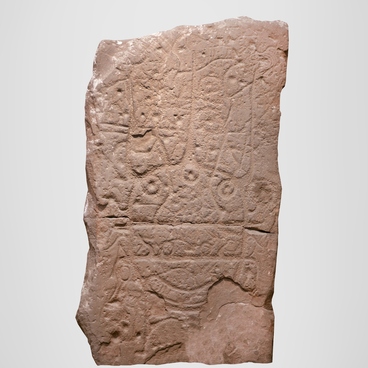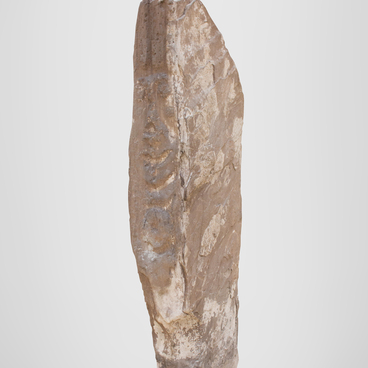A large stela of Devonian sandstone was found in 1958 in the valley of the Askiz River on the left bank of the river near the Balgan ulus of the Askiz region. The archaeological expedition in the valley was led by Leonid Kyzlasov. The stela was dug into the embankment of a large Tagar kurgan 150 meters east-northeast of the Chitykhys chaatas, one of the medieval burial structures that are found only in the Khakass-Minusinsk depression.
The Chaatas, or stones of war, were what the Khakass called groups of stone burial mounds enclosed by high slabs or stone pillars — mengirs — roughly hewn obelisks. For menhirs, the Khakass often used statues or stelas with drawings of the ancient Okunev or Tagar (8th-3rd century BC) culture. Almost all chaatases were built on the old cemeteries of the Tashtyk culture, which existed from the 2nd century BC to the 5th century AD and was the successor of the Tagar culture. Chaatases stretched in a chain from the south or southeast to the north or northwest.
On Kyzlasov’s instructions, this stela, 369 centimeters high, was transported to the Khakass Regional Museum of Local History in 1958 by archaeologist Albert Lipsky. The stela belongs to the Okunev archaeological culture of the late 3rd — early 2nd millennium BC.
Using pecking technique on sandstone, the master depicted a solar deity — the source of life of nature and man in the views of the ancient population of Siberia. The master divided the main mask into two parts with a horizontal line. The upper one corresponded to the celestial zone of the sculpture: three holes designated the eyes, to which serpentine extensions stretch from the outer edge. From the dividing line down the center, the master made a serpentine arch — the nose. Below he placed a wide mouth in the form of an oval groove, along the edges of which open triangles are pecked. He depicted the chin in the form of three arched lines with three branches extending upward.
From the lower edge of the main mask, three branches extend downward, on the left side between them one more small mask is inscribed, and on the right are figures of animals. Presumably, they cover the mask located below the main one and preserved only partially.
At the very bottom of the stela, the master engraved the figure of an animal. Two lines run from his head, merge into one, and then split into three. One end of the line adjoins the circle-shaped sign, and the other circle is located between the two branches. This drawing, judging by the application technique, was made later than the main masks.
The Chaatas, or stones of war, were what the Khakass called groups of stone burial mounds enclosed by high slabs or stone pillars — mengirs — roughly hewn obelisks. For menhirs, the Khakass often used statues or stelas with drawings of the ancient Okunev or Tagar (8th-3rd century BC) culture. Almost all chaatases were built on the old cemeteries of the Tashtyk culture, which existed from the 2nd century BC to the 5th century AD and was the successor of the Tagar culture. Chaatases stretched in a chain from the south or southeast to the north or northwest.
On Kyzlasov’s instructions, this stela, 369 centimeters high, was transported to the Khakass Regional Museum of Local History in 1958 by archaeologist Albert Lipsky. The stela belongs to the Okunev archaeological culture of the late 3rd — early 2nd millennium BC.
Using pecking technique on sandstone, the master depicted a solar deity — the source of life of nature and man in the views of the ancient population of Siberia. The master divided the main mask into two parts with a horizontal line. The upper one corresponded to the celestial zone of the sculpture: three holes designated the eyes, to which serpentine extensions stretch from the outer edge. From the dividing line down the center, the master made a serpentine arch — the nose. Below he placed a wide mouth in the form of an oval groove, along the edges of which open triangles are pecked. He depicted the chin in the form of three arched lines with three branches extending upward.
From the lower edge of the main mask, three branches extend downward, on the left side between them one more small mask is inscribed, and on the right are figures of animals. Presumably, they cover the mask located below the main one and preserved only partially.
At the very bottom of the stela, the master engraved the figure of an animal. Two lines run from his head, merge into one, and then split into three. One end of the line adjoins the circle-shaped sign, and the other circle is located between the two branches. This drawing, judging by the application technique, was made later than the main masks.



